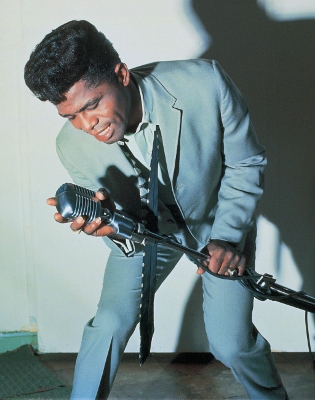
Known as the “Godfather of Soul” to “The Hardest Working Man in Show Business,” James Brown was a musical legend who bridged unforgettable sounds and moves with expressive lyrics. A hero in Black culture and music, Brown not only made fans dance but gave a message lasting beyond the end of his song. He emerged as was one of the founding fathers of funk, his musical style often influencing R&B, jazz and rock.
Brown created “feel good music,” that implied a greater meaning. He used his platform for social and political activism performing at demonstrations for civil rights organizations in the 1960s.
The music legend created the notable songs that encompassed political and social change.
“Say It Loud- I’m Black and I’m proud” resonated as an anthem to Blacks as way to promote pride and identity during the heart of the Black Power in the late 1960s and early 1970s. The single was a social commentary to the struggle and progress of African Americans moving from self-doubt to self-determination. “People called “Black and Proud” militant and angry, maybe because of the line about dying on your feet instead of living on your knees. But really, if you listen to it, it sounds like a children’s song. That’s why I had children in it, so children who heard it could grow up feeling pride… The song cost me a lot of my crossover audience. The racial makeup at my concerts was mostly black after that. I don’t regret it, though, even if it was misunderstood,” Brown once stated. Prior to the anthem he recorded “America Is My Home” in response to the anti-war advocacy during the Vietnam. He encouraged patriotism and overcoming adversity in America with lyrics “stop pitying yourselves and get up and fight.”
Funk song “I Don’t Want Nobody to Give Me Nothing (Open Up the Door I’ll Get It Myself)” promoted equality and self-reliance for Blacks to do for themselves instead relying on America. In response to Black leaders for not being outspoken enough, he recorded “Talkin’ Loud and Sayin’ Nothing” in 1970.
“Funky President,” according to Brown referred to U.S. President Gerald Ford, who succeeded Richard Nixon in the White House shortly before it was recorded. Lyric, “People, people we got it over, before we go under” signified Blacks beating social and economic welfare versus being defeated by the government.”
Brown’s “Don’t Be a Drop-Out” emphasized pro-education due to dropout rates in the 1960s. Brown who dropped out of school at the seventh grade knew the significance of being an advocate for education amongst the youth. He made public speeches in schools. Residuals from the song were donated to charities that had dropout prevention programs. Aside from investing in the youth, he developed Black businesses for the community.
While he spoke to the political and sphere, he didn’t shy away of from social problems affecting Black communities. Singles “King Heroin” and the ballad “Public Enemy” from album There It Is dealt with drug addiction.
Putting his activism to work the day after the assassination of Martin Luther King, Jr., he gave a televised concert at the Boston Garden on April 5, 1968. Following King’s death. Many neighborhoods resorting to riot. City officials feared extensive violence. Wanting to resist brutality, former mayor of Boston, Kevin White was influenced by Brown to broadcast his concert multiple times on Boston’s public television station, WGBH, thus keeping potential rioters off the street.
Aside from his social and political songs, he created notorious songs that echoed lyrical meaning. Notable single “Papa’s Got a Brand New Bag,” sings the praises of an old man brave enough to get out on the dance floor of a nightclub (“Brand new bag” meaning new interest, taste, or way of doing something). The single earned him his first Grammy Award, for Best Rhythm & Blues Recording. “It’s a Man’s Man’s Man’s World” spoke to the man’s significance without a woman.
A unique artist, Brown captured his audience with soulful and political lyrics, not forgetting his electric dance moves. His limitless talents influenced everyone from Rolling Stone’s Mick Jagger whom he met early in his career. Jagger, who is one of the producers of the James Brown biopic Get on Up, recalled in a Time interview “I copied all his moves… Everyone did the microphone trick, where you pushed the microphone, then you put your foot on it and it comes back, and then you catch it.” Great in his own right, Michael Jackson, patterned his musical style after Brown, publically reflecting on the soulful artist as “…My greatest inspiration.” In 1986, he was inducted into the Rock and Roll Hall of Fame. He died on December 25, 2006 from congestive heart failure resulting from complications of pneumonia. He was 73 years old.
shonassee@lasentinel.net






